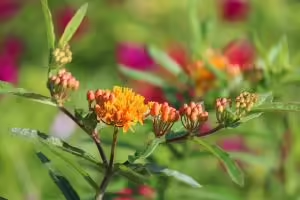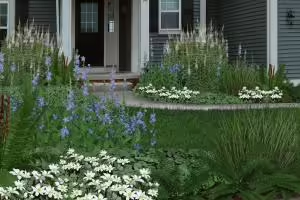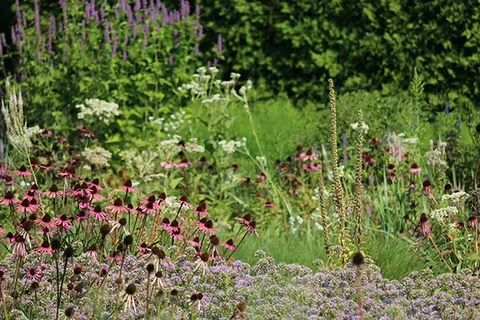Plants for Wet Areas
Skip mowing. Use native plants to soak up excess rainwater.
Traditional lawns are planted with non-native grasses that have minimal root systems. Those lawns shed the majority of rainwater that falls on them, adding to localized flooding. Instead, consider converting lawn into gardens or plants trees on your property to soak up more rainwater. When possible, utilize plant species that are native to your region, as many of them have extensive root systems that absorb water like a sponge, helping to reduce flooding.
For design inspiration, look to natural areas, although you may want to interpret your design for the property’s scale, which is likely smaller. One strategy is to emphasize an iconic feature, such as a mass planting of Prairie Dropseed with seasonal flowers, to represent a prairie. Another approach is to contain the bed with a defined border. Whatever your design, check local municipal or homeowner’s association ordinances to ensure compliance.
These tips will guide your success
- Know your property’s site conditions and select native plants that work best for them.
- Before digging, call JULIE at 811 or 800-892-0123 or visit www.illinois1call.com to place a local utility request. When you know it’s safe to dig, start by preparing your garden bed.
- If you are using small plugs, consider soaking them in a small bucket. It can be difficult to rehydrate them once they dry out.
- To plant, dig a hole as deep and a little wider than the pot the plant came in. If the plant is root-bound, cutoff the bottom ¼ inch of the roots to stimulate new growth. Place the plant in the hole and backfill with soil. Be sure the level of the plant’s soil matches the level of the ground around it.
- Add 2 to 3 inches of natural shredded mulch, leaving a circle approximately 2 inches in diameter of bare soil around the stem.
- Water your new plants every other day for two weeks if it doesn’t rain. After two weeks, additional watering may be necessary if the weather is hot and dry.
- Your native plant may not bloom in the first two years while it’s busy putting down deep roots. To have color during perennial establishment, you can intermingle them with annuals.
- Although native plants are often described as low maintenance, this does not mean no maintenance, especially in the first two years. During this critical time, expect to pull weeds and to maintain the mulch layer to discourage unwanted plants.

Select Your Landscape Plants
Here's a quick read for choosing suitable landscape plants.
Use Native Garden Plants
Learn more with Illinois native plant garden designs
